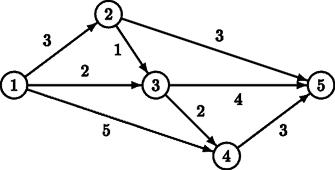标签:des style blog http color io os ar java
| Time Limit: 2000MS | Memory Limit: 65536K | |
| Total Submissions: 7627 | Accepted: 2798 |
Description
Bessie has moved to a small farm and sometimes enjoys returning to visit one of her best friends. She does not want to get to her old home too quickly, because she likes the scenery along the way. She has decided to take the second-shortest rather than the shortest path. She knows there must be some second-shortest path.
The countryside consists of R (1 ≤ R ≤ 100,000) bidirectional roads, each linking two of the N (1 ≤ N ≤ 5000) intersections, conveniently numbered 1..N. Bessie starts at intersection 1, and her friend (the destination) is at intersection N.
The second-shortest path may share roads with any of the shortest paths, and it may backtrack i.e., use the same road or intersection more than once. The second-shortest path is the shortest path whose length is longer than the shortest path(s) (i.e., if two or more shortest paths exist, the second-shortest path is the one whose length is longer than those but no longer than any other path).
Input
Output
Sample Input
4 4 1 2 100 2 4 200 2 3 250 3 4 100
Sample Output
450
题目意思:
给一个结点个数为n,边数为m的无向图,求1到n之间的次短路长度。
思路:
需要深刻理解dijkstra算法的贪心原理。普通点的dijkstra算法是用一个结点k的最短路径更新与k相连没被visited的结点的最短路径。
那么同理也可以更新次短路经。
1到一个结点k的最短路径或可以更新与k相连结点j的最短路径或次短路经。
当遍历到k时,此时没被遍历过的最短路径结点为k的最短路径或者k的次短路经。设dis[k][mark]为遍历到k时最短路径或次短路经(mark=1时为k的最短路径,mark为2时为k的次短路经),与k相连的没有被遍历过得结点为j,w为k与j之间一条边的权值。
那么
若dis[j][1]>dis[k][mark]+w时更新j的最短路径长度(及个数,HDU3191会用到,代码中也加了更新个数的代码,在本题中可以删去),次短路经长度(及个数)。
若dis[j][1]==dis[k][mark]+w时更新j的最短路径个数。
若dis[j][1]<dis[k][mark]+w<dis[j][2]更新j的次短路经长度及个数。
若dis[j][2]==dis[k][mark]+w时更新j的次短路经个数。
代码:
1 #include <cstdio> 2 #include <algorithm> 3 #include <iostream> 4 #include <cstring> 5 #include <vector> 6 #include <queue> 7 using namespace std; 8 9 #define N 5005 10 #define inf 1999999999 11 12 struct mem{ 13 int y, w; 14 }; 15 16 vector<mem>ve[N]; 17 int n, m; 18 int dis[N][3]; 19 int visited[N][3]; 20 int num[N][3]; 21 int S, E; 22 23 void dijkstra(){ 24 int i, j; 25 int u, ma; 26 mem p, q; 27 memset(visited,0,sizeof(visited)); 28 memset(num,0,sizeof(num)); 29 for(i=0;i<=n;i++){ 30 for(j=1;j<=2;j++) 31 dis[i][j]=inf; 32 } 33 dis[S][1]=0;num[S][1]=1; 34 for(i=0;i<2*n;i++){ 35 int tmp=inf; 36 for(j=1;j<=n;j++){ 37 if(!visited[j][1]&&dis[j][1]<tmp){ 38 u=j;ma=1;tmp=dis[j][1]; 39 } 40 else if(!visited[j][2]&&dis[j][2]<tmp){ 41 u=j;ma=2;tmp=dis[j][2]; 42 } 43 } 44 if(tmp==inf) break; 45 visited[u][ma]=1; 46 for(j=0;j<ve[u].size();j++){ 47 p=ve[u][j]; 48 if(dis[p.y][1]>dis[u][ma]+p.w){ 49 dis[p.y][2]=dis[p.y][1]; 50 num[p.y][2]=num[p.y][1]; 51 dis[p.y][1]=dis[u][ma]+p.w; 52 num[p.y][1]=num[u][ma]; 53 } 54 else if(dis[p.y][1]==dis[u][ma]+p.w){ 55 num[p.y][1]+=num[u][ma]; 56 } 57 else if(dis[p.y][2]>dis[u][ma]+p.w){ 58 dis[p.y][2]=dis[u][ma]+p.w; 59 num[p.y][2]=num[u][ma]; 60 } 61 else if(dis[p.y][2]==dis[u][ma]+p.w){ 62 num[p.y][2]+=num[u][ma]; 63 } 64 } 65 } 66 } 67 main() 68 { 69 int i, j, t; 70 mem p; 71 int x, y, z; 72 73 while(scanf("%d %d",&n,&m)==2){ 74 75 for(i=0;i<=n;i++) ve[i].clear(); 76 while(m--){ 77 scanf("%d %d %d",&x,&y,&z); 78 p.y=y;p.w=z; 79 ve[x].push_back(p); 80 p.y=x; 81 ve[y].push_back(p); 82 } 83 S=1;E=n; 84 dijkstra(); 85 printf("%d\n",dis[n][2]); 86 } 87 }
HDU 3191
Time Limit: 2000/1000 MS (Java/Others) Memory Limit: 32768/32768 K (Java/Others)
Total Submission(s): 1115 Accepted Submission(s): 377
1 #include <cstdio> 2 #include <algorithm> 3 #include <iostream> 4 #include <cstring> 5 #include <vector> 6 #include <queue> 7 using namespace std; 8 9 #define N 55 10 #define inf INT_MAX 11 12 struct mem{ 13 int y, w; 14 }; 15 16 vector<mem>ve[N]; 17 int n, m; 18 int dis[N][3]; 19 int visited[N][3]; 20 int num[N][3]; 21 int S, E; 22 23 void dijkstra(){ 24 int i, j; 25 int u, ma; 26 mem p, q; 27 memset(visited,0,sizeof(visited)); 28 memset(num,0,sizeof(num)); 29 for(i=0;i<=n;i++){ 30 for(j=1;j<=2;j++) 31 dis[i][j]=inf; 32 } 33 dis[S][1]=0;num[S][1]=1; 34 for(i=0;i<2*n;i++){ 35 int tmp=inf; 36 for(j=0;j<n;j++){ 37 if(!visited[j][1]&&dis[j][1]<tmp){ 38 u=j;ma=1;tmp=dis[j][1]; 39 } 40 else if(!visited[j][2]&&dis[j][2]<tmp){ 41 u=j;ma=2;tmp=dis[j][2]; 42 } 43 } 44 if(tmp==inf) break; 45 if(visited[u][ma]) continue; 46 visited[u][ma]=1; 47 for(j=0;j<ve[u].size();j++){ 48 p=ve[u][j]; 49 if(dis[p.y][1]>dis[u][ma]+p.w){ 50 dis[p.y][2]=dis[p.y][1]; 51 num[p.y][2]=num[p.y][1]; 52 dis[p.y][1]=dis[u][ma]+p.w; 53 num[p.y][1]=num[u][ma]; 54 } 55 else if(dis[p.y][1]==dis[u][ma]+p.w){ 56 num[p.y][1]+=num[u][ma]; 57 } 58 else if(dis[p.y][2]>dis[u][ma]+p.w){ 59 dis[p.y][2]=dis[u][ma]+p.w; 60 num[p.y][2]=num[u][ma]; 61 } 62 else if(dis[p.y][2]==dis[u][ma]+p.w){ 63 num[p.y][2]+=num[u][ma]; 64 } 65 } 66 } 67 68 } 69 main() 70 { 71 int i, j; 72 mem p; 73 int x, y, z; 74 while(scanf("%d %d %d %d",&n,&m,&S,&E)==4){ 75 for(i=0;i<=n;i++) ve[i].clear(); 76 while(m--){ 77 scanf("%d %d %d",&x,&y,&z); 78 p.y=y;p.w=z; 79 ve[x].push_back(p); 80 } 81 dijkstra(); 82 printf("%d %d\n",dis[E][2],num[E][2]); 83 } 84 }
HDU 1688
Time Limit: 3000/1000 MS (Java/Others) Memory Limit: 32768/32768 K (Java/Others)
Total Submission(s): 677 Accepted Submission(s): 272

1 #include <cstdio> 2 #include <algorithm> 3 #include <iostream> 4 #include <cstring> 5 #include <vector> 6 #include <queue> 7 using namespace std; 8 9 #define N 1005 10 #define inf INT_MAX 11 12 struct mem{ 13 int y, w; 14 }; 15 16 vector<mem>ve[N]; 17 int n, m; 18 int dis[N][3]; 19 int visited[N][3]; 20 int num[N][3]; 21 int S, E; 22 23 void dijkstra(){ 24 int i, j; 25 int u, ma; 26 mem p, q; 27 memset(visited,0,sizeof(visited)); 28 memset(num,0,sizeof(num)); 29 for(i=0;i<=n;i++){ 30 for(j=1;j<=2;j++) 31 dis[i][j]=inf; 32 } 33 dis[S][1]=0;num[S][1]=1; 34 for(i=0;i<2*n;i++){ 35 int tmp=inf; 36 for(j=1;j<=n;j++){ 37 if(!visited[j][1]&&dis[j][1]<tmp){ 38 u=j;ma=1;tmp=dis[j][1]; 39 } 40 else if(!visited[j][2]&&dis[j][2]<tmp){ 41 u=j;ma=2;tmp=dis[j][2]; 42 } 43 } 44 if(tmp==inf) break; 45 visited[u][ma]=1; 46 for(j=0;j<ve[u].size();j++){ 47 p=ve[u][j]; 48 if(dis[p.y][1]>dis[u][ma]+p.w){ 49 dis[p.y][2]=dis[p.y][1]; 50 num[p.y][2]=num[p.y][1]; 51 dis[p.y][1]=dis[u][ma]+p.w; 52 num[p.y][1]=num[u][ma]; 53 } 54 else if(dis[p.y][1]==dis[u][ma]+p.w){ 55 num[p.y][1]+=num[u][ma]; 56 } 57 else if(dis[p.y][2]>dis[u][ma]+p.w){ 58 dis[p.y][2]=dis[u][ma]+p.w; 59 num[p.y][2]=num[u][ma]; 60 } 61 else if(dis[p.y][2]==dis[u][ma]+p.w){ 62 num[p.y][2]+=num[u][ma]; 63 } 64 } 65 } 66 } 67 main() 68 { 69 int i, j, t; 70 mem p; 71 int x, y, z; 72 73 cin>>t; 74 while(t--){ 75 scanf("%d %d",&n,&m); 76 for(i=0;i<=n;i++) ve[i].clear(); 77 while(m--){ 78 scanf("%d %d %d",&x,&y,&z); 79 p.y=y;p.w=z; 80 ve[x].push_back(p); 81 } 82 scanf("%d %d",&S,&E); 83 dijkstra(); 84 if(dis[E][2]==dis[E][1]+1) printf("%d\n",num[E][1]+num[E][2]); 85 else printf("%d\n",num[E][1]); 86 } 87 }
POJ 3255 && HDU 1688 && HDU 3191 次短路问题
标签:des style blog http color io os ar java
原文地址:http://www.cnblogs.com/qq1012662902/p/4001006.html